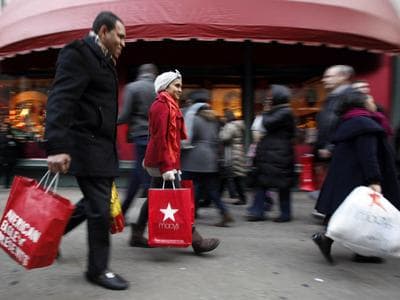Advertisement
Stronger Consumer Spending Boosts U.S. Growth

The economy gained strength at the end of last year as Americans spent at the fastest pace in four years and U.S. companies sold more overseas.
The growth is boosting hopes for a stronger 2011. But it remains too weak to ease high unemployment.
The Commerce Department reported Friday that growth rose to an annual rate of 3.2 percent in the October-December quarter. That's better than the 2.6 percent growth in the previous quarter. And it was the best quarterly showing since the start of last year.
The economy has now consistently picked up speed since hitting a rough path in the spring.
Geithner: Unemployment Won't Fall Fast
Speaking at the World Economic Forum in Davos, Switzerland Friday, U.S. Treasury Secretary Tim Geithner said that "there's more confidence now that the most acute part of the [financial] crisis is over, absolutely in the U.S. but that is even true globally."
He added that the mood in the world's biggest economy was improved because "we've got sustained expansion," but warned "It's not a boom. It's not going to offer the prospect of a rapid decline in the unemployment rate."
For all of last year, the economy grew 2.9 percent, the most since 2005. It was an improvement from 2009, when the economy suffered its worst decline in more than 60 years.
But that won't be strong enough growth to drive down unemployment, which was 9.4 percent in December. It takes about 3 percent growth just to create enough jobs to keep pace with the population increase. By some estimates, growth would have to be closer to 5 percent for a full year to drive down the unemployment rate by 1 percentage point.
Consumer Spending Boosts Optimism
Increased consumer spending was a key reason the economy grew more strongly. Americans boosted their spending at a 4.4 percent pace, the most since 2006. They spent more on furnishings, appliances, cars and clothes.
That's largely why economists are more optimistic about the economy's performance this year. Consumer spending accounts for roughly 70 percent of overall economic activity.
After the recession ended in June 2009, consumers kept spending cautiously. At the end of last year, though, that began to change.
Looking ahead, economists expect consumer spending will rise 3.2 percent or more for all of 2011. That would be almost double last year's anemic rate.
A cut in workers' Social Security taxes, higher stock prices and wage gains from a slowly healing jobs market should make people feel better about spending, economists say.
Economists are hopeful that consumers can power the economy, especially as government stimulus fades and businesses spend less replenishing their stockpiles.
Companies spent just $7.2 billion on inventories in the October-December, compared to a $121.4 billion increase in the July-September quarter. Inventories investment, which had been an important source of growth since the recession ended, subtracted from economic growth for the first time since the second quarter of 2009.
Exports Also Fuel Growth
Stronger sales of U.S. exports to foreign buyers helped fuel growth at the end of last year, but the higher sales were eclipsed by the slowdown in inventory rebuilding.
Exports grew at a 10 percent pace, up from a 5.8 percent pace in the July-September quarter. Economists expect sales of exports to continue to provide support for the economy this year.
Business spending on equipment and software also helped growth in the October-December quarter. Businesses also started spending again on home building and commercial construction projects after deep cutbacks.
Government spending, however, stopped being a source of growth for the economy at the end of last year. It dipped 0.6 percent in the October-December quarter — the first drop since the start of 2010. The pullback reflected cuts in spending by the federal government on defense and by state and local governments, which are struggling with budget problems. Federal spending on non-defense projects, however, grew.
For all of this year, the economy is expected to grow 3.2 percent, according to a new AP Economy Survey.
Economists in the AP Economy Survey predict the unemployment rate will rise to 9.5 percent in January. The government releases the January employment report next week. The unemployment rate is expected to drop to 8.9 percent by the end of this year, the survey says.
This program aired on January 28, 2011. The audio for this program is not available.